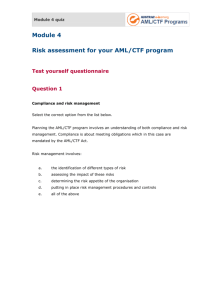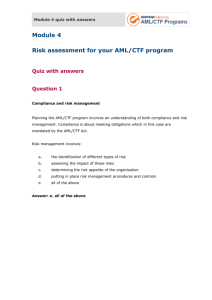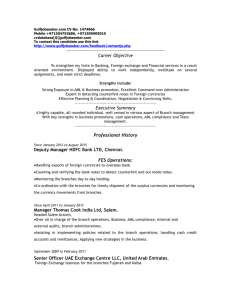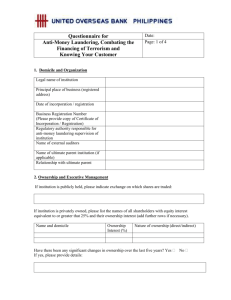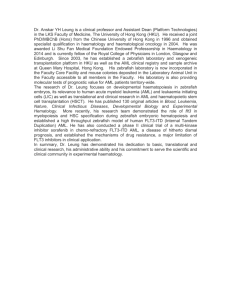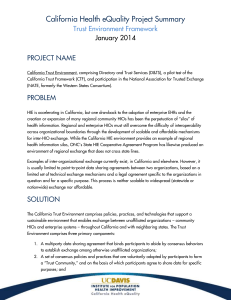PLI 11 – Electronic funds transfer instructions and international
advertisement
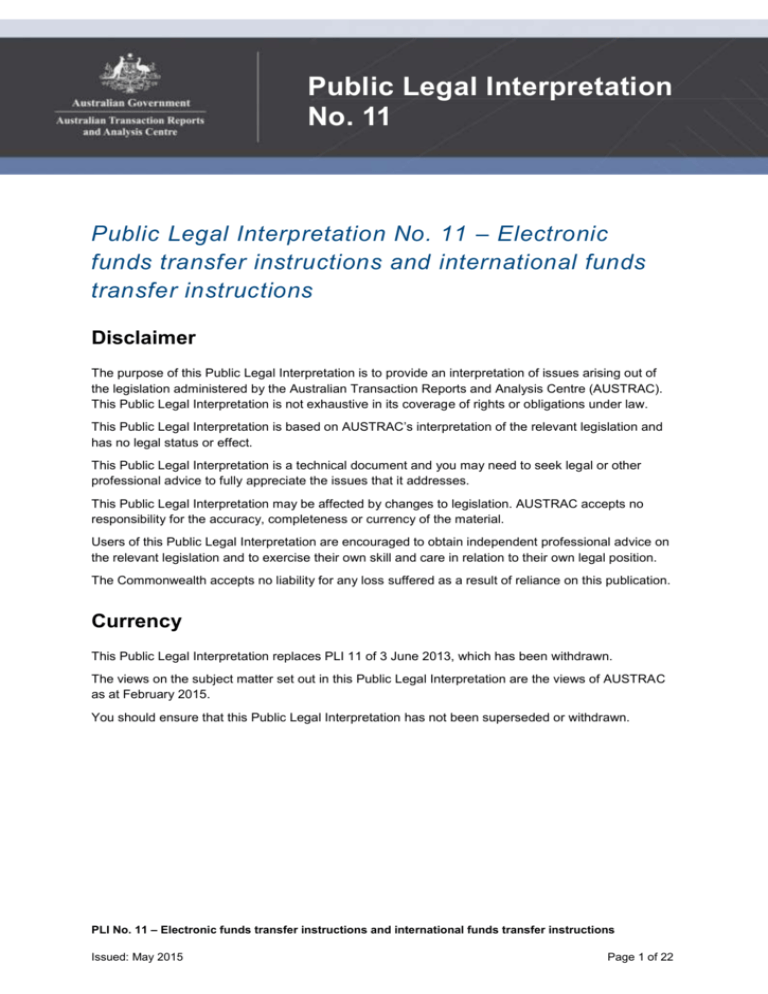
Public Legal Interpretation No. 11 Public Legal Interpretation No. 11 – Electronic funds transfer instructions and international funds transfer instructions Disclaimer The purpose of this Public Legal Interpretation is to provide an interpretation of issues arising out of the legislation administered by the Australian Transaction Reports and Analysis Centre (AUSTRAC). This Public Legal Interpretation is not exhaustive in its coverage of rights or obligations under law. This Public Legal Interpretation is based on AUSTRAC’s interpretation of the relevant legislation and has no legal status or effect. This Public Legal Interpretation is a technical document and you may need to seek legal or other professional advice to fully appreciate the issues that it addresses. This Public Legal Interpretation may be affected by changes to legislation. AUSTRAC accepts no responsibility for the accuracy, completeness or currency of the material. Users of this Public Legal Interpretation are encouraged to obtain independent professional advice on the relevant legislation and to exercise their own skill and care in relation to their own legal position. The Commonwealth accepts no liability for any loss suffered as a result of reliance on this publication. Currency This Public Legal Interpretation replaces PLI 11 of 3 June 2013, which has been withdrawn. The views on the subject matter set out in this Public Legal Interpretation are the views of AUSTRAC as at February 2015. You should ensure that this Public Legal Interpretation has not been superseded or withdrawn. PLI No. 11 – Electronic funds transfer instructions and international funds transfer instructions Issued: May 2015 Page 1 of 22 Contents Objective .................................................................................................................................................. 3 Introduction .............................................................................................................................................. 3 Outline of interpretation ........................................................................................................................... 4 Interpretation ........................................................................................................................................... 4 Related Information ............................................................................................................................... 21 Further Information ................................................................................................................................ 22 PLI No. 11 – Electronic funds transfer instructions and international funds transfer instructions Issued: May 2015 Page 2 of 22 Objective 1. The purpose of this Public Legal Interpretation (PLI) is to set out AUSTRAC’s views on the provisions of the Anti-Money Laundering and Counter-Terrorism Financing Act 2006 (AML/CTF Act) as they relate to electronic funds transfer instructions (EFTIs) referred to in items 29 and 30 of Table 1 in section 6 of the AML/CTF Act, and in Part 5 of that Act and international funds transfer instructions (IFTIs) which fall within items 1 and 2 in section 46 of the AML/CTF Act (which are referred to in this PLI, generally, as IFTI-Es). 2. This PLI does not deal with international funds transfer instructions for a transfer under a designated remittance arrangement which fall within items 3 and 4 in section 46 of the AML/CTF Act. This PLI also does not deal with issues associated with agency which may apply in respect to EFTIs and IFTI-Es. The topic of agency is addressed in Public Legal Interpretation No. 10 – Agency and the AML/CTF Act (PLI 10). Introduction 3. The objects of the AML/CTF Act include fulfilling Australia’s international obligations and addressing matters of international concern in relation to combating money laundering and the financing of terrorism. These international obligations include a commitment to bring Australia’s AML/CTF regime in line with the international standards as set out by the Financial Action Taskforce on Money Laundering (FATF). To fulfil these obligations and address matters of international concern, the AML/CTF Act places certain obligations on reporting entities and other persons in relation to particular types of transactions and events. 4. Section 45 of the AML/CTF Act, which commenced operation on 12 December 2008, requires that a person who sends or receives an international funds transfer instruction, transmitted into or out of Australia, must report certain information about the transaction to AUSTRAC. 5. Separately, and in addition to the reporting requirement under section 45 of the AML/CTF Act, Part 5 of the AML/CTF Act (which commenced operation on 13 December 2006) imposes obligations on various persons involved in an electronic funds transfer instruction (‘ordering institutions’, ‘beneficiary institutions’ and ‘interposed institutions’) to record, obtain, include and/or pass on certain information about the electronic funds transfer instruction (including where it is an international funds transfer instruction) and, if required, report such information to AUSTRAC. 6. Various exemptions are contained in section 67 of the AML/CTF Act which may mean that certain persons are not required to comply with the requirements in Part 5 of the AML/CTF Act, but are still required to comply with the international funds transfer instruction reporting requirement in section 45 of the AML/CTF Act. 7. AUSTRAC has also previously issued Public Legal Interpretation No. 3 of 2008 – Registration as a provider of registrable designated remittance services (PLI 3) which addresses designated remittance arrangements and instructions given under such arrangements, including those sent to and received from international destinations (items 3 and 4 in section 46 of the AML/CTF Act). PLI No. 11 – Electronic funds transfer instructions and international funds transfer instructions Issued: May 2015 Page 3 of 22 Outline of interpretation 8. This Public Legal Interpretation deals with: A. What is an electronic funds transfer instruction (EFTI) Legislative provisions (paragraph 10) The parties involved in an EFTI (paragraph 13) B. Obligations imposed by the AML/CTF Act in relation to EFTIs Aspects of the AML/CTF Act involving EFTIs (paragraph 15) EFTI-related designated services (paragraph 166) C. Requirements in regard to EFTIs – Part 5 of the AML/CTF Act Overview of requirements (paragraph 18) What information is required to be obtained, included or passed on in regard to EFTIs? (paragraph 22) Exceptions to the requirements to obtain, include or pass on certain information in EFTIs and IFTI-Es (paragraph 49) General comments on the exemptions in section 67 of the AML/CTF Act (paragraph 59) D. EFTIs which are international funds transfer instructions (IFTI-Es) – Part 3 of the AML/CTF Act: What is an international funds transfer instruction (IFTI)? (paragraph 611) Is sending or receiving an IFTI, which is an EFTI (IFTI-E), a designated service? (paragraph 66) General IFTI reporting requirements (paragraph 688) What additional information is required to be obtained, included or passed on in regard to IFTI-Es? (paragraph 71) What is a ‘permanent establishment’? (paragraph 800) Interpretation 9. The topics discussed in this PLI are: 9.1. The AML/CTF Act describes particular types of electronic transactions as EFTIs (sections 8 and 9). 9.2. EFTIs are relevant to some designated services provided by reporting entities under the AML/CTF Act – in particular, items 29 and 30 in Table 1 in section 6 of the AML/CTF Act. 9.3. Part 5 of the AML/CTF Act requires that information be collected about EFTIs and that certain ‘transfer information’ be sent with certain EFTIs. 9.4. Certain EFTIs are also IFTI-Es and attract reporting obligations under Division 4 of Part 3 of the AML/CTF Act. PLI No. 11 – Electronic funds transfer instructions and international funds transfer instructions Issued: May 2015 Page 4 of 22 A. What is an electronic funds transfer instruction (EFTI)? Legislative provisions 10. Section 5 of the AML/CTF Act defines electronic funds transfer instruction (EFTI) as follows: electronic funds transfer instruction means: a)a multiple-institution person-to-person electronic funds transfer instruction; or b)a same-institution person-to-person electronic funds transfer instruction; or c) a multiple-institution same-person electronic funds transfer instruction; or d)a same-institution same-person electronic funds transfer instruction 11. Each of those four types of EFTIs is then separately defined in section 5, but each definition refers to either section 8 or 9 of the AML/CTF Act. 12. From sections 8 and 9 of the AML/CTF Act, an EFTI has the following characteristics: 12.1. It is an instruction given by a payer to an ordering institution (paragraphs 8(1)(a), 8(2)(a), 9(1)(a) and 9(2)(a) of the AML/CTF Act). 12.2. The instruction is to transfer money controlled by the payer to a payee by either: 12.2.1. being paid directly to the payee by a beneficiary institution; or 12.2.2. being credited to the account of the payee with the beneficiary institution (subsections 8(1), 8(2), 9(1) and 9(2) of the AML/CTF Act). 12.3. The instruction must relate to money controlled by the payer (paragraphs 8(1)(a) and 9(1)(a) of the AML/CTF Act). 12.4. Both the ordering institution and the beneficiary institution must be an authorised deposittaking institution (ADI), bank, building society, credit union or a person specified in the AML/CTF Rules. These institutions all make up the definition of ‘financial institution’ for the purposes of the AML/CTF Act and are referred to collectively as ‘financial institutions’ in this PLI. AML/CTF Rules have been made for the purposes of the two definitions – Chapter 51 of the AML/CTF Rules specifies persons for these purposes. If a ‘nonfinancial institution’ is involved as either an ordering institution or a beneficiary institution, it will not be an EFTI (paragraphs 8(1)(c) and (d), 8(2)(c), 9(1)(c) and (d) and 9(2)(c) of the AML/CTF Act). 12.5. For multiple-institution EFTIs, either the transfer of money must be carried out, or the transfer instruction must be passed on, wholly or partly by means of one or more electronic communications (paragraphs 8(1)(b) and 9(1)(b) of the AML/CTF Act). 12.6. For same-institution EFTIs, only the transfer of money must be carried out wholly or partly by means of one or more electronic communications (see paragraphs 8(2)(b) and 9(2)(b) of the AML/CTF Act). The parties involved in an EFTI 13. There needs to be four parties for there to be an EFTI: a payer, a payee, an ordering institution and a beneficiary institution. For a same-institution EFTI, the ordering and beneficiary institution are the same financial institution and for a same-person EFTI, the payer and payee are the same person. There would always therefore need to be at least a payer/ payee and a separate ordering/ beneficiary institution for there to be an EFTI. A financial institution sending an instruction on its own behalf or receiving it from a financial institution acting on its own behalf would therefore not be considered a party to an EFTI under the AML/CTF regime, as there would be no payer or payee. Subsection 67(5) of the AML/CTF Act further provides that inter-financial institution transfers are exempt from any EFTI reporting obligations. PLI No. 11 – Electronic funds transfer instructions and international funds transfer instructions Issued: May 2015 Page 5 of 22 14. The AML/CTF Act uses different terms to describe the different parties which are normally involved in an IFTI-E, these are as follows: Party Defined where? Definition/role Payer person who controls the money to be transferred. person who instructs the ordering institution to transfer the money. in a same-person EFTI, the payer is the same person as the payee. person who is instructed to transfer money controlled by the payer to the payee. must be an ADI, bank, building society, credit union or a person specified in the AML/CTF Rules. in a same-institution EFTI, the ordering institution is the same person as the beneficiary institution (ie. the same legal entity). either the ordering institution or the interposed institution. the institution which transmits the instruction out of Australia to the foreign interposed institution or beneficiary institution (for IFTI reporting purposes). either the interposed institution or the beneficiary institution. the institution which receives the instruction transmitted from outside Australia (for IFTI reporting purposes). Ordering institution Sender/ transmitter (relevant to IFTI-Es) Recipient (relevant to IFTI-Es) section 5, then further in sections 8 and 9 of the AML/CTF Act section 5, then further in sections 8 and 9 of the AML/CTF Act Not specifically defined in the AML/CTF Act subsection 45(1) of the AML/CTF Act sets out who is a sender and subsection 45(5) of the AML/CTF Act further clarifies who the sender is. referred to in Chapter 16 of the AML/CTF Rules Not specifically defined in the AML/CTF Act. subsection 45(1) of the AML/CTF Act sets out who is a recipient and subsection 45(5) of the AML/CTF Act further clarifies who the recipient is. PLI No. 11 – Electronic funds transfer instructions and international funds transfer instructions Issued: May 2015 Page 6 of 22 Party Defined where? Definition/role Interposed institution(s) Not specifically defined in the AML/CTF Act or AML/CTF Rules. subsection 64(2) of the AML/CTF Act defines ‘institution’ as including a person interposed between the ordering and beneficiary institutions in the funds transfer chain. person interposed between the ordering institution and the beneficiary institution who receives and passes on the EFTI to the beneficiary institution or another person in the funds transfer chain. subsection 45(5) of the AML/CTF Act and subparagraph 16.2(12)(b) and 16.3(3)(m) of the AML/CTF Rules refer to interposed institutions. paragraphs 8(1)(f) and 9(1)(g) of the AML/CTF Act refer to ‘interposed persons’ (they have the same meaning as ‘interposed institutions’). section 5, then further in sections 8 and 9 of the AML/CTF Act must be an ADI, bank, building society, credit union or a person specified in the AML/CTF Rules: with whom the payee holds an account; or who pays the money transferred as a result of an EFTI to the payee. in a same-institution EFTI, the beneficiary institution is the same person as the ordering institution (ie the same legal entity). person to whom the payer wishes to transfer (or has arranged transfer of) money controlled by it. In other words, the payee is the ultimate intended beneficiary of the transferred money. person to whom the beneficiary institution makes the transferred money available. payee must: Beneficiary institution Payee section 5, then further in sections 8 and 9 of the AML/CTF Act. physically receive the money; or have an account with the beneficiary institution credited with the amount of money transferred by the payer. in a same-person EFTI, the payee is the same person as the payer. PLI No. 11 – Electronic funds transfer instructions and international funds transfer instructions Issued: May 2015 Page 7 of 22 B. Obligations imposed by the AML/CTF Act in relation to EFTIs Aspects of the AML/CTF Act involving EFTIs 15. The AML/CTF Act imposes a range of obligations in relation to EFTIs: 15.1. If the EFTI forms part of a ‘designated service’ the reporting entity providing that designated service has the normal obligations imposed on reporting entities by the AML/CTF Act; 15.2. Institutions which are involved with an EFTI may have reporting and information transmission obligations under Part 5 of the AML/CTF Act, whether or not they are reporting entities and whether or not that EFTI forms part of a designated service. 15.3. If the EFTI is part of an IFTI-E there may be reporting obligations under Part 3 of the AML/CTF Act. Those obligations are discussed in following sections of this PLI. EFTI-related designated services 16. Much of the AML/CTF Act is directed to obligations of reporting entities providing designated services. There are two designated services in table 1 in subsection 6(2) of the AML/CTF Act which directly involve an EFTI – accepting an instruction in the capacity of ordering institution (item 29) and making money available as a result of a transfer under an EFTI (item 30). A person who provides either of those services, and who has the required ‘geographical link’ with Australia (subsection 6(6) of the AML/CTF Act) is a reporting entity under the AML/CTF Act and, unless exempted, has the normal obligations the AML/CTF Act imposes on all reporting entities regarding the provision of designated services, including: 16.1. customer identification (Part 2 of the AML/CTF Act); 16.2. reporting (Part 3 of the AML/CTF Act); 16.3. adopting and maintaining an anti-money laundering and counter-terrorism financing program (Part 7 of the AML/CTF Act); and 16.4. record-keeping (Part 10 of the AML/CTF Act). As those normal reporting entity obligations have been dealt with extensively in other AUSTRAC publications they will not be further explored in this PLI. 17. The ‘geographical link’ with Australia which is required for a service described in the tables in section 6 of the AML/CTF Act to be a ‘designated service’ is set out in subsection 6(6): i. the service is provided at or through a permanent establishment of the person in Australia; or ii. both of the following subparagraphs apply: b. the person is a resident of Australia; c. the service is provided at or through a permanent establishment of the person in a foreign country; or i. both of the following subparagraphs apply: ii. the person is a subsidiary of a company that is a resident of Australia; iii. the service is provided at or through a permanent establishment of the person in a foreign country. PLI No. 11 – Electronic funds transfer instructions and international funds transfer instructions Issued: May 2015 Page 8 of 22 General requirements in regard to EFTIs – Part 5 of the AML/CTF Act C. Overview of requirements 18. Part 5 (sections 63 to 72) of the AML/CTF Act imposes obligations on persons involved with EFTI transactions. These are additional to the obligations on a reporting entity for item 29 and 30 designated services (see previous section). 19. Obligations under Part 5 can fall on any ‘institution’ in a ‘funds transfer chain’, whether or not that ‘institution’ is a reporting entity. ‘Funds transfer chain’ is defined in subsection 64(2) as: 24.1 the ordering institution; 24.2 any interposed institution; and 24.3 the beneficiary institution. (See the table in paragraph 14 above describing the parties to an EFTI.) 20. Part 5 obligations are to collect and supply two types of information. The obligations apply to domestic EFTIs (that is, where the ordering institution and beneficiary institution both provide the relevant EFTI-related service at or through a permanent establishment in Australia), as well as international EFTIs, although the obligations relating to ‘outgoing’ international EFTIs can be different to the obligations relating to ‘incoming’ international EFTIs. 21. The different requirements imposed by Part 5 are discussed under the subheadings below. What information is required to be obtained, included or passed on in regard to EFTIs? 22. Depending on the type of EFTI, different information must be collected by or passed on to the institutions in a funds transfer chain. The types of information are: 22.1. ‘Complete payer information’ (defined in section 5 of the AML/CTF Act with further reference to section 71 of the AML/CTF Act). 22.2. ’Tracing information’ (defined in section 5 of the AML/CTF Act with further reference to section 72 of the AML/CTF Act). 22.3. ‘Required transfer information’ (defined in section 5 of the AML/CTF Act with further reference to section 70 of the AML/CTF Act) – which is either ‘complete payer information’ or ‘tracing information’. 23. Briefly: 23.1. ‘Complete payer information’ is basically the payer’s name, a ‘positive identifier’ (full address, date of birth, or a unique identification number linked to identification records) and either an account number or transaction identifying number. 23.2. ’Tracing information’ is either an account number or transaction identifying number. 24. The requirements to collect and report information are dealt with under the next three subheadings, followed by the requirements to pass on transfer information with an EFTI (under the subheading ‘Required transfer information’). Sections 64 and 65 of the AML/CTF Act – multiple-institution EFTIs 25. Section 64 of the AML/CTF Act outlines obligations to collect and report information in regard to multiple-institution EFTIs where the transfer instruction is: PLI No. 11 – Electronic funds transfer instructions and international funds transfer instructions Issued: May 2015 Page 9 of 22 25.1. accepted by the ordering institution at or through a permanent establishment of the ordering institution in Australia; or 25.2. passed on to the interposed institution at or through a permanent establishment in Australia. It applies to both: multiple-institution person-to-person EFTIs; and multiple-institution same-person EFTIs. Both of these types of multiple-institution EFTIs are defined separately in section 5 of the AML/CTF Act. 26. The following two examples illustrate multiple-institution EFTIs: Example 1: Multiple-institution person-to-person EFTI In this example: Amy (the payer) holds an account with the ABC Bank. Michael holds an account with the XYZ Bank (beneficiary institution). Both XYZ Bank and ABC Bank are Australian banks. Amy gives an instruction to the ABC Bank (ordering institution) to transfer money to Michael’s (the payee’s) bank account. The instruction is passed from ABC Bank to XYZ Bank through ABC Bank’s subsidiary funds transfer communication company, ABC Pty Ltd. Amy Michael (payer) (payee) transfer instruction funds transfer ABC Bank Amy’s account (ordering institution) ABC Pty Ltd (interposed institution) XYZ Bank – Michael’s account (beneficiary institution) transfer instruction 1. Diagram example of multi-institution same-person EFTI Example 2: Multiple-institution same-person EFTI In this example: Peter holds an account with both ABC Bank and XYZ Bank. ABC Bank and XYZ Bank are Australian banks. Peter gives ABC Bank (ordering institution) an instruction to transfer money to the account he holds with XYZ Bank (beneficiary institution). In this case, Peter is both the payer and payee (making this a same-person EFTI). PLI No. 11 – Electronic funds transfer instructions and international funds transfer instructions Issued: May 2015 Page 10 of 22 Because the instruction is being passed on by ABC Bank to XYZ Bank, this makes it a multiple-institution EFTI. Peter (payer/payee) transfer instruction funds ABC Bank (ordering institution) - Peter’s Account transfer transfer instruction XYZ Bank (beneficiary institution) – Peter’s Account 2. Diagram example of multi-institution same-person EFTI 27. In both examples, ABC Bank, as the ordering institution which accepted the transfer instruction, must obtain the ‘complete payer information’ before: 27.1. passing on; 27.2. dispatching; or 27.3. taking any other action to carry out; the transfer instruction – subsection 64(3) of the AML/CTF Act. A failure to comply with subsection 64(3) of the AML/CTF Act is a contravention of a civil penalty provision and may result in a civil penalty. 28. If the ordering institution which accepted the transfer instruction at or through a permanent establishment in Australia, is in a ‘funds transfer chain’ (see subsection 64(2)), then before passing on the transfer instruction to another person in the chain, the ordering institution must ensure that the transfer instruction includes the ‘required transfer information’ – subsection 64(6) of the AML/CTF Act. A failure to comply with subsection 64(6) of the AML/CTF Act is a contravention of a civil penalty provision and may result in a civil penalty. Only in Example 1 is there a ‘funds transfer chain’. ABC Bank must pass on the ‘required transfer information’ to ABC Pty Ltd. 29. Section 64 of the AML/CTF Act does not impose obligations on beneficiary institutions. 30. While there is no automatic requirement for ordering institutions to report ‘complete payer information’ obtained under subsection 64(3) of the AML/CTF Act to AUSTRAC or to the beneficiary institution, it can be requested from the ordering institution by either the AUSTRAC CEO (under subsection 64(4) of the AML/CTF Act) or the beneficiary institution (under subsection 64(5) of the AML/CTF Act). This is even if the beneficiary institution is in a foreign country and the instruction is accepted at or through a permanent establishment of the ordering institution in Australia. The same timeframes apply for providing the ‘complete payer information’ to the requesting party under both subsections 64(4) and 64(5) of the AML/CTF Act (3 days for requests received within 6 months). A failure to comply with subsection 64(5) of the AML/CTF Act is a contravention of a civil penalty provision and may result in a civil penalty. Obligations of interposed institutions 31. In regard to funds transfer chains, there is a requirement for interposed institutions to pass on or include certain information received about the transfer instruction when passing on the transfer instruction to the next person in the funds transfer chain. More specifically, where: PLI No. 11 – Electronic funds transfer instructions and international funds transfer instructions Issued: May 2015 Page 11 of 22 31.1. the transfer instruction is accepted by an ordering institution at or through a permanent establishment of the ordering institution in Australia; or 31.2. the making available by the beneficiary institution of the transferred money would take place at or through a permanent establishment of an Australian beneficiary institution; and the interposed institution: receives; or passes on; the transfer instruction at or through a permanent establishment in Australia, and the transfer instruction contains some or all of the required transfer information passed on by another institution in the funds transfer chain then, before passing on the transfer instruction to another institution in the chain, the interposed institution must ensure that the transfer instruction includes so much of the ‘required transfer information’ as was passed on to the interposed institution (see paragraph 64(7)(f) of the AML/CTF Act). In simple terms, paragraph 64(7)(f) of the AML/CTF Act applies to: domestic EFTIs; and outgoing IFTI-Es. 32. If the transfer instruction is accepted by the ordering institution at or through a foreign permanent establishment of the ordering institution (that is, there is an incoming IFTI-E), then the Australian interposed institution must ensure that, before passing on the transfer instruction to another institution in the funds transfer chain, the instruction includes the ‘tracing information’ (see paragraph 64(7)(e) of the AML/CTF Act). 33. A failure to comply with subsection 64(7) of the AML/CTF Act is a contravention of a civil penalty provision and may result in a civil penalty. Section 66 of the AML/CTF Act – same-institution EFTIs 34. Section 66 of the AML/CTF Act applies to both: 34.1. same-institution person-to-person EFTIs; and 34.2. same-institution same-person EFTIs, if the instruction is to be carried out otherwise than by way of transferring money from an account held by the payer with the ordering institution in a particular country, to another account held by the payer with the ordering institution in that same country. That is, section 66 of the AML/CTF Act would not apply if for example a customer gave an instruction at a branch of a bank in Australia, to transfer money between two accounts of the customer which are both held with the same bank in New Zealand (that is, both accounts are in one country). 35. Examples 3 and 4 illustrate same-institution EFTIs: Example 3 – Same-institution person-to-person EFTI In this example: Sarah holds an account with the ABC Bank. Brian also holds an account with the ABC Bank (same institution). Sarah gives an instruction to the ABC Bank (ordering institution) to transfer money to Brian’s account, which he also holds with the ABC Bank (beneficiary institution). In this case, the ABC Bank is both the ordering institution and the beneficiary institution (making this a same-institution EFTI). Because the instruction is to transfer money from Sarah to Brian, it is a person-toperson EFTI. PLI No. 11 – Electronic funds transfer instructions and international funds transfer instructions Issued: May 2015 Page 12 of 22 Sarah Brian (payer) (payee) transfer instruction funds ABC Bank as ordering institution – Sarah’s account transfer transfer instruction ABC Bank as beneficiary institution – Brian’s account 3. Diagram example of Same-institution same-person EFTI In this example: Amy holds a savings account and an investment account with the ABC Bank. ABC Bank has a permanent establishment in both Australia and New Zealand. Amy’s savings account is held with the Australian permanent establishment, while the investment account is held with the New Zealand permanent establishment. Amy gives an instruction at the Australian permanent establishment of ABC Bank (ordering institution) to transfer money from her savings account to her investment account held with the New Zealand permanent establishment of the ABC Bank (beneficiary institution). In this case, Amy is both the payer and payee (making this a same-person EFTI). Because the instruction is being passed on by the Australian permanent establishment of ABC Bank to the New Zealand permanent establishment of the ABC Bank, this is a same-institution IFTI-E. Amy – payer/payee transfer instruction funds ABC Bank as ordering institution, from Amy’s savings account held in Australia transfer transfer instruction ABC Bank as beneficiary institution, to Amy’s investment account held in New Zealand 4. Diagram example of same ordering institution and beneficiary institution 36. In this example, the ordering institution and the beneficiary institution are the same person (that is, they are the same legal entity). 37. Section 66 of the AML/CTF Act applies to same-institution EFTIs where: 37.1. the transfer instruction is accepted by the ordering institution at or through a permanent establishment of the ordering institution in Australia; or 37.2. the making available of the transferred money by the beneficiary institution would take place at or through an Australian permanent establishment of the beneficiary institution. PLI No. 11 – Electronic funds transfer instructions and international funds transfer instructions Issued: May 2015 Page 13 of 22 Section 66 of the AML/CTF Act requires the beneficiary institution to obtain the ‘complete payer information’ before it makes the transferred money available to the payee (subsection 66(2) of the AML/CTF Act). A failure to comply with subsection 66(2) of the AML/CTF Act is a contravention of a civil penalty provision and may result in a civil penalty being applied. 38. In the case of an IFTI-E sent out of Australia, the obligation is placed on a beneficiary institution before it provides a designated service in a foreign country, although the ordering and beneficiary institution are the same person in a same-institution EFTI. 39. The AUSTRAC CEO has the power, under subsection 66(3) to request that this ‘complete payer information’ be provided to AUSTRAC. Required transfer information 40. Section 70 of the AML/CTF Act prescribes what required transfer information must be included for different types of EFTIs – either tracing information or complete payer information. (This has been referred to in the discussion above of different types of EFTIs, but is consolidated in this section of this PLI). 41. The first type of EFTI is described in paragraph 70(a) – EFTI instructions described in the AML/CTF Rules. Chapter 12 is the relevant part of the AML/CTF Rules. Paragraph 70(a) requires, by reference to the AML/CTF Rules, that if the transfer instruction is one where money is to be paid by use of a credit card, then only tracing information must be included in the EFTI (unless the transaction involves e-currency and is an instruction described in paragraph 70(c), which is a nonbatched IFTI-E, in which case complete payer information is required). 42. Paragraph 70(b) of the AML/CTF Act deals with ‘batched’ EFTIs. The definition of a ‘batched electronic funds transfer instruction’ is contained in section 5 of the AML/CTF Act. The definition in section 5 requires that a ‘batched EFTI’ must contain the complete payer information in respect of each of the EFTIs in the batch. However, paragraph 70(b) provides that for a ‘batched IFTI-E’, the required transfer information is the tracing information (if paragraph 70(a) of the AML/CTF Act does not apply). Paragraph 70(a) will apply in regard to all batched IFTI-Es where money is to be paid by use of a credit card. 43. Paragraph 70(c) of the AML/CTF Act applies to non-batched IFTI-Es, for which the required transfer information is the complete payer information (if paragraph 70(a) of the AML/CTF Act does not apply). Paragraph 70(a) will apply in regard to non-batched IFTI-Es where money is to be paid by use of a credit card and the transaction does not involve e-currency. 44. Paragraph 70(d) of the AML/CTF Act applies to domestic EFTIs and sets out that the required transfer information is the tracing information (if paragraph 70(a) of the AML/CTF Act does not apply). Paragraph 70(a) will apply in regard to all domestic EFTIs which relate to a payment of money by use of a credit card. 45. In summary, the required transfer information is the tracing information in all cases except for a non-batched IFTI-E where: 45.1. money is paid otherwise than by the use of a credit card; or 45.2. money is paid by the use of a credit card and the transaction involves e-currency. For these two types of non-batched IFTI-Es, the required transfer information is the complete payer information. 46. In the case of some IFTI-Es some ‘interposed institutions’ are obliged to keep records for 7 years of the ‘required transfer information’ – see section 115 of the AML/CTF Act. 47. Section 70 of the AML/CTF Act falls within Part 5 of that Act. If any of the exemptions in section 67 of AML/CTF Act apply, there is no obligation to include required transfer information in the exempted EFTI. PLI No. 11 – Electronic funds transfer instructions and international funds transfer instructions Issued: May 2015 Page 14 of 22 48. Below is a table which summarises the effect of section 70 of the AML/CTF Act and Chapter 12 of the AML/CTF Rules: REQUIRED TRANSFER INFORMATION (section 70 of the AML/CTF Act) DOMESTIC OR INTERNATIONAL INTERNATIONAL Complete payer information (defined in section 71 of the AML/CTF Act) TYPE OF EFTI no credit card use batched EFTI money paid by use of credit card batched EFTI Tracing information (defined in section 72 of the AML/CTF Act) Paragraph 70(b) of the AML/CTF Act Paragraph 70(a) Paragraph 12.2 of the AML/CTF Rules Paragraph 70(a) of the AML/CTF Act Paragraph 12.2 of the AML/CTF Rules money paid by use of credit card non-batched EFTI involves e-currency money paid by use of credit card non-batched EFTI no e-currency no credit card use non-batched EFTI no credit card use Paragraph 70(c) of the AML/CTF Act Paragraph 12.3 of the AML/CTF Rules Paragraph 70(c) of the AML/CTF Act Paragraph 70(d) of the AML/CTF Act Paragraph 70(a) of the AML/CTF Act DOMESTIC (BATCHED AND NON-BATCHED) money paid by use of credit card PLI No. 11 – Electronic funds transfer instructions and international funds transfer instructions Issued: May 2015 Page 15 of 22 Exceptions to the requirements to obtain, include or pass on certain information in EFTIs and IFTI-Es 49. Section 67 of the AML/CTF Act provides exceptions to the requirements contained in Part 5 of the AML/CTF Act. Part 5 does not apply to instructions arising from the use of, or which relate to, the following: 49.1. Approved third-party bill systems; 49.2. Debit cards and credit cards; 49.3. Cheques; 49.4. ATMs; 49.5. Merchant terminals; 49.6. Inter-financial institution transfers; and 49.7. Instructions prescribed by the AML/CTF Rules (none of which have been made to date). Each of these categories is addressed in more detail below. Approved third-party bill systems (subsection 67(1) of the AML/CTF Act) 50. Chapter 13 of the AML/CTF Rules defines ‘third-party bill payment systems’ to mean BPAY, direct electronic funds transfer (DEFT) and the Australian Payments Clearing Association Limited’s direct entry system. DEFT is defined in the AML/CTF Rules as: ‘DEFT’ means direct electronic funds transfer which is a payment, collection, receipting and reconciliation service that enables the payment of bills by customers registered with the DEFT scheme through the internet, BPAY, Australia Post offices, telephone or mail. Debit cards and credit cards (subsections 67(2) and 67(2A) of the AML/CTF Act) 51. The exception in subsection 67(2) of the AML/CTF Act covers instructions which arise from the use of a debit card or credit card if: 51.1. the use does not involve obtaining a cash advance; and 51.2. the number of the card is included in the instruction; and 51.3. the card is not of the kind specified in the AML/CTF Rules; and 51.4. the use does not take place in circumstances of a kind specified in the AML/CTF Rules. 52. In addition, subsection 67(2A) of the AML/CTF Act provides that Part 5 does not apply to instructions that arise from the use of a debit card or a credit card at a branch of a financial institution if: 52.1. the number of the card is included in the instruction; and 52.2. the card is not of a kind specified in the AML/CTF Rules; and 52.3. the use does not take place in circumstances of a kind specified in the AML/CTF Rules. 53. No AML/CTF Rules have been made for the purposes of subsections 67(2) and 67(2A) of the AML/CTF Act. 54. This means that an instruction arising from the use of a debit or credit card (except obtaining a cash advance from a place which is not a branch of a financial institution) which does not include the card number is caught by the requirements in Part 5 of the AML/CTF Act, but could still be exempted under subsections 67(4) or 67(4A) of the AML/CTF Act (instructions given by the use of an ATM and merchant terminal, respectively – see below). PLI No. 11 – Electronic funds transfer instructions and international funds transfer instructions Issued: May 2015 Page 16 of 22 Cheques (subsection 67(3) of the AML/CTF Act) 55. Instructions given by way of a cheque are exempt from Part 5 of the AML/CTF Act unless the cheque is of a kind specified in the AML/CTF Rules. To date, no AML/CTF Rules have been made for the purposes of subsection 67(3) of the AML/CTF Act. ATMs (subsection 67(4) of the AML/CTF Act) 56. Subsection 67(4) of the AML/CTF Act exempts instructions given by the use of an ATM from Part 5 of the AML/CTF Act if: 56.1. the ATM is not of a kind specified in the AML/CTF Rules; and 56.2. the use does not take place in circumstances of a kind specified in the AML/CTF Rules. No AML/CTF Rules have yet been made for the purposes of subsection 67(4) of the AML/CTF Act. Merchant terminals (subsection 67(4A) of the AML/CTF Act) 57. Subsection 67(4A) of the AML/CTF Act exempts instructions given by way of the operation of a merchant terminal from Part 5 of the AML/CTF Act if: 57.1. the operation is authorised by a financial institution; and 57.2. the merchant terminal is not of a kind specified in the AML/CTF Rules; and 57.3. the operation does not take place in circumstances of a kind specified in the AML/CTF Rules. No AML/CTF Rules have yet been made for the purpose of subsection 67(4A) of the AML/CTF Act. Inter-financial institution transfers (subsection 67(5) of the AML/CTF Act) 58. Part 5 of the AML/CTF Act does not apply to transfers of money between two financial institutions if each financial institution acts on its own behalf. General comments on the exemptions in section 67 of the AML/CTF Act 59. As noted above subsection 67(2) provides that Part 5 of the AML/CTF Act does not apply to credit or debit cards specified in the AML/CTF Rules, or used in circumstances specified in the Rules. However, no Rules have been made for the purposes of subsection 67(2). 60. Section 67 only exempts institutions from complying with Part 5 of the AML/CTF Act. Sections 6 (list of all designated services), 8, 9, 32 (carrying out the applicable customer identification procedure before the commencement of the provision of a designated service), 45 (IFTI reporting) and 46 do not fall within Part 5 of the AML/CTF Act, and are not affected by section 67. The obligations to: 60.1. identify a customer before commencing to provide the designated services in items 29 and 30 of table 1 of subsection 6(2) of the AML/CTF Act; and 60.2. report an IFTI-E (items 1 and 2 in section 46 of the AML/CTF Act) under section 45 of the AML/CTF Act; as well as comply with any other obligations in the AML/CTF Act, such as section 41 (suspicious matter reporting) and 43 (threshold transaction reporting) of the AML/CTF Act still apply to the provision of designated services which relate to EFTIs which fall within the exceptions in section 67 of the AML/CTF Act. PLI No. 11 – Electronic funds transfer instructions and international funds transfer instructions Issued: May 2015 Page 17 of 22 D. EFTIs which are international funds transfer instructions (IFTI-Es) – Part 3 of the AML/CTF Act What is an international funds transfer instruction (IFTI)? 61. ‘International funds transfer instruction’ is defined in section 5 of the AML/CTF Act as follows: international funds transfer instruction has the meaning given by section 46. 62. Section 46 of the AML/CTF Act describes four (4) types of IFTIs: 62.1. IFTI-E (outgoing). An instruction accepted at or through a permanent establishment of an ordering institution in Australia and the transferred money is to be, or is, made available at or through a permanent establishment of the beneficiary institution in a foreign country. 62.2. IFTI-E (incoming). An instruction accepted at or through a permanent establishment of an ordering institution in a foreign country and the transferred money is to be, or is, made available at or through a permanent establishment of the beneficiary institution in Australia. 62.3. (IFTI-DRA) (outgoing). An instruction for the transfer of money or property under a designated remittance arrangement - where the instruction is accepted at or through a permanent establishment of a person in Australia and the money or property is or is to be made available to the ultimate transferee at or through a permanent establishment of a person in a foreign country. 62.4. IFTI-DRA (incoming). An instruction for the transfer of money or property under a designated remittance arrangement – where the instruction is accepted at or through a permanent establishment of a person in a foreign country and the money or property is or is to be made available to the ultimate transferee at or through a permanent establishment of a person in Australia. 63. IFTIs are, therefore, not only restricted to those relating to electronic funds transfer instructions. They can also include instructions relating to international designated remittance arrangements. This PLI does not address designated remittance arrangements. AUSTRAC has issued a separate PLI on designated remittance arrangements Public Legal Interpretation No. 3 of 2008 – Registration as a provider of registrable designated remittance services (PLI 3). 64. Money involved in an IFTI-E can be denominated in Australian dollars or a foreign currency, or may be for the transfer of e-currency. 65. The focus of section 46 of the AML/CTF Act is on: 65.1. where the instruction is accepted from the payer (in Australia or overseas); and 65.2. where the money is made available to the payee. As a minimum, for section 46 of the AML/CTF Act to apply, there either needs to be a beneficiary institution making money available, or an ordering institution accepting an instruction at or through, a permanent establishment in Australia. Is sending or receiving an IFTI, which is an EFTI (IFTI-E), a designated service? 66. As noted in paragraph 16 of this PLI, accepting an instruction in the capacity of ordering institution and making money available as a result of a transfer under an EFTI are designated services. This applies equally to an IFTI-E. PLI No. 11 – Electronic funds transfer instructions and international funds transfer instructions Issued: May 2015 Page 18 of 22 67. However, sending or receiving an IFTI-E is not a designated service (within any of the items in the tables in section 6 of the AML/CTF Act), so if a person sends or receives an IFTI-E which is reportable under subsection 45(5) of the AML/CTF Act, outside the provision of a designated service, that person is not required to identify the customer in respect to the provision of that section 45 service. (If the person is also providing a designated service under item 29 or 30 of table 1 in subsection 6(1) they must still identify the customer in respect of the section 6 designated service.) General IFTI reporting requirements 68. All IFTIs must be reported to AUSTRAC pursuant to section 45 of the AML/CTF Act. 69. IFTI reports must be given to the AUSTRAC CEO within 10 business days after the day on which the instruction was sent or received by the person (subsection 45(2) of the AML/CTF Act). There is no minimum threshold amount which applies in regard to IFTI reporting. A failure to comply with the IFTI reporting obligation in section 45 of the AML/CTF Act is a contravention of a civil penalty provision and may result in a civil penalty. 70. The obligation to lodge an IFTI report under section 45 of the AML/CTF Act falls on one of the following two (2) persons: 70.1. the sender of an IFTI transmitted out of Australia; or 70.2. the recipient of an IFTI transmitted into Australia, who may not necessarily be the same person as the: 70.3. ordering institution (for an IFTI-E); or 70.4. beneficiary institution (for an IFTI-E). It does not matter for section 45 whether or not the person sending or receiving the IFTI is a reporting entity. What additional information is required to be obtained, included or passed on in regard to IFTI-Es? 71. Sending or receiving an IFTI-E, requires compliance with the mandatory IFTI reporting obligation under section 45 of the AML/CTF Act, as well as compliance with the information requirements in Part 5 of the AML/CTF Act described in the section above about Part 5. 72. In addition to the normal Part 5 requirements, the AUSTRAC CEO can impose a requirement on the beneficiary institution of an incoming IFTI-E to obtain, include and pass on required transfer information in all future IFTI-Es. Section 65 of the AML/CTF Act allows the AUSTRAC CEO to give beneficiary institutions a written notice directing them to request the ordering institution to include required transfer information in all future IFTI-Es. 73. Subsection 65(2) of the AML/CTF Act provides that, where there is an incoming IFTI-E, if: 73.1. the beneficiary institution has received 2 or more electronic funds transfer instructions from a particular ordering institution; and 73.2. at least one of the electronic funds transfer instructions does not include the required transfer information; then the AUSTRAC CEO, may, by written notice given to the beneficiary institution, direct the beneficiary institution to give the ordering institution a request (in a form specified in the notice) to include required transfer information in all future electronic funds transfer instructions passed on by the ordering institution to the beneficiary institution. PLI No. 11 – Electronic funds transfer instructions and international funds transfer instructions Issued: May 2015 Page 19 of 22 74. A failure by the beneficiary institution to make such a request to the ordering institution is a contravention of a civil penalty provision and may result in a civil penalty (subsection 65(5) of the AML/CTF Act). 75. A beneficiary institution must comply with a direction given by the AUSTRAC CEO under subsection 65(2) of the AML/CTF Act within 10 business days of the direction being given (subsection 65(2) of the AML/CTF Act). In addition to giving such a request to the ordering institution, the beneficiary institution is required to give the AUSTRAC CEO a report about the ordering institution’s response, or lack of response, to the request: 75.1. within 20 business days after the day on which the AUSTRAC CEO direction was given to the beneficiary institution; or 75.2. within such longer period allowed by the AUSTRAC CEO in a written notice given to the beneficiary institution (subsection 65(3) of the AML/CTF Act). The report must be in the approved form and contain such information as is required. A failure to comply with this reporting requirement is a contravention of a civil penalty provision and may result in a civil penalty (subsection 65(5) of the AML/CTF Act). 76. If the ordering institution fails to include the required transfer information, as requested by the beneficiary institution pursuant to subsection 65(2) of the AML/CTF Act, the beneficiary institution may refuse to make the transferred money available to the payee until the required transfer information is passed on by the ordering institution (subsection 65(6) of the AML/CTF Act). However, such a refusal can only be made by the beneficiary institution for the purpose of: 76.1. identifying; or 76.2. mitigating; or 76.3. managing; the risk that the beneficiary institution may reasonably face that the making available of the transferred money at or through a permanent establishment of the beneficiary institution in Australia might (whether inadvertently of otherwise) involve or facilitate money laundering or financing of terrorism (subsection 65(7) of the AML/CTF Act). 77. The AML/CTF Act is silent on how a beneficiary institution should handle the transferred money once it has identified, mitigated or managed such risk. However, note that the beneficiary institution, or an officer, employee or agent of the beneficiary institution, is protected from liability for anything done, or not done, in the exercise, or purported exercise, of the power provided in subsection 65(6) of the AML/CTF Act, under subsection 65(8). 78. A summary of the various types of EFTIs and IFTIs and the information which must be included in, or obtained in respect of, each type is set out in the table below: Type of EFTI DOMESTIC Type of EFTI DOMESTIC Type of EFTI Person- to Person comply with section 66 comply with sections 45 and 66 comply with section 64 comply with sections 45, 64 + 65 (if an incoming IFTI-E) comply with section 66 comply with sections 45 and 66 comply with section 64 comply with sections 45, 64 + 65 (if an incoming IFTI-E) (defined in section 8) Same person (defined in section 9) (but, exempt from section 66 if transfer is between accounts) PLI No. 11 – Electronic funds transfer instructions and international funds transfer instructions Issued: May 2015 Page 20 of 22 79. In addition, if compliance with any of sections 54, 65 or 66 of the AML/CTF Act is required, the requirements of sections 70 -72 of the AML/CTF Act (outlined in paragraphs 23-49 of this PLI) must also be considered and complied with (if applicable). What is a ‘permanent establishment’? 80. An IFTI is only reportable under section 45 of the AML/CTF Act, if there is a relevant nexus to a permanent establishment in Australia of either the ordering institution or beneficiary institution (depending on whether it is an outgoing or incoming IFTI) – see section 46. 81. ‘Permanent establishment’ is defined in section 21 of the AML/CTF Act. A permanent establishment includes a place where an ordering institution or beneficiary institution carries on activities or business through an agent (subsection 21(1) of the AML/CTF Act) and can include mobile services (subsection 21(2)). Related Information Anti-Money Laundering and Counter-Terrorism Financing Act 2006 Click here to view the Anti-Money Laundering and Counter-Terrorism Financing Act 2006 : (www.comlaw.gov.au/comlaw/management.nsf/lookupindexpagesbyid/IP200627290?OpenDocument) Legislative instruments The Anti-Money Laundering and Counter-Terrorism Financing Rules Instrument 2007 (No. 1) (AML/CTF Rules) provide the following relevant Rules: Rules at Chapter 12 in relation to electronic funds transfer instructions Rules at Chapter 16 in relation to ‘Reportable details for international funds transfer instructions (items 1 and 2 in section 46)’ Rules at Chapter 17 in relation to ‘Reportable details for international funds transfer instructions (items 3 and 4 in section 46)’. Click here to view the AML/CTF Rules. (http://www.comlaw.gov.au/comlaw/management.nsf/lookupindexpagesbyid/IP200730563?OpenDocu ment) AUSTRAC publications Public Legal Interpretation No. 3 – Registration as a provider of registrable designated remittance services (PLI 3) provides AUSTRAC’s view on the meaning of international funds transfer instructions under the AML/CTF Act. Public Legal Interpretation No. 10 – Agency and the AML/CTF Act (PLI 10) deals with issues associated with agency which may apply in respect to EFTIs and IFTI-Es. Click here to view the AUSTRAC Reporting policy (http://www.austrac.gov.au/report_policy.html.) The AUSTRAC Compliance Guide contains guidance on obligations under the AML/CTF Act. Chapter 7 contains information regarding reporting obligations for IFTI-Es and IFTI DRAs. (www.austrac.gov.au/businesses/obligations-and-compliance/austrac-compliance-guide.) PLI No. 11 – Electronic funds transfer instructions and international funds transfer instructions Issued: May 2015 Page 21 of 22 Further Information Privacy Act 1988 Reporting entities should note that in relation to activities they undertake to comply with the AML/CTF Act, they will have obligations under the Privacy Act 1988, including the requirement to comply with the Australian Privacy Principles, even if they would otherwise be exempt from the Privacy Act. For further information about these obligations, please go to http://www.privacy.gov.au or call 1300 363 992. AUSTRAC Contact Centre AUSTRAC officers are able to assist reporting entities, their staff and the public in providing general information relating to the AML/CTF Act. Enquiries can be directed to the AUSTRAC Help Desk via: email to help_desk@austrac.gov.au telephone 02 9950 0827 or 1300 021 037 (a local call within Australia). February 2015 © Commonwealth of Australia, 2015 PLI No. 11 – Electronic funds transfer instructions and international funds transfer instructions Issued: May 2015 Page 22 of 22
